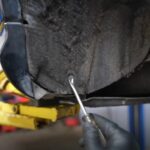The dreaded “no crank” situation can be frustrating for any car owner, especially when dealing with a sophisticated machine like a BMW. This article examines a real-world scenario involving a 2009 BMW E60 530d that refused to crank, throwing the enigmatic A0C1 and A0C2 fault codes. We’ll delve into the troubleshooting process and ultimately reveal the surprising culprit behind this starting issue.
Initial Symptoms and Troubleshooting
The owner initially suspected a faulty glow plug relay due to pre-existing fault codes related to the glow plugs. The car would crank but not start in cold weather, a common symptom of glow plug issues. However, on a warmer day, the car started after some effort. After driving for a short period and clearing the codes, the vehicle refused to crank altogether, displaying the A0C1 and A0C2 codes. These codes point to a potential problem with the Car Access System (CAS), a critical component responsible for various functions, including starting authorization.
Jumpstarting proved unsuccessful, ruling out a simple low battery issue. Further investigation was needed to pinpoint the root cause. The owner, facing a car stranded inoperable, was left with several possibilities: a malfunctioning CAS module, a faulty starter, or wiring issues within the starting circuit. Replacing the CAS module is a costly and complex procedure, often requiring specialized programming. Similarly, diagnosing and replacing a starter can be labor-intensive.
The Unexpected Culprit: A Corroded Ground Cable
After further inspection, the owner discovered the true culprit: a corroded ground cable connecting the engine to the frame. This seemingly minor issue had significant consequences. A corroded ground cable disrupts the electrical pathway, preventing the starter from receiving the necessary current to engage the engine. Replacing the corroded cable with a new one immediately resolved the starting problem.
This case highlights the importance of thorough inspection and systematic troubleshooting when dealing with complex automotive electrical systems. While the A0C1 and A0C2 codes initially suggested a CAS-related problem, the actual cause was a much simpler and less expensive fix. It serves as a reminder that not all fault codes directly indicate the failing component and that seemingly minor issues can have major impacts on vehicle operation.
Conclusion: Lessons Learned from a BMW No-Crank Scenario
The Bmw A0c1 and A0C2 fault codes, while potentially indicating a CAS issue, can also be triggered by other problems within the starting circuit. This case study emphasizes the importance of checking fundamental components like ground cables before assuming more complex and expensive repairs are necessary. A corroded ground cable can effectively disable a vehicle, mimicking symptoms of more serious malfunctions. Always prioritize a thorough visual inspection and basic electrical checks as part of your diagnostic process. This approach can save time and money by identifying simple solutions to seemingly complex automotive problems.
